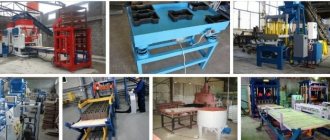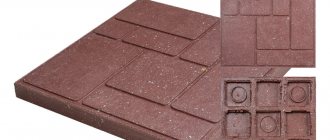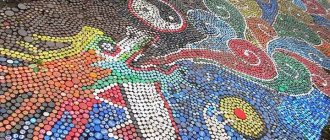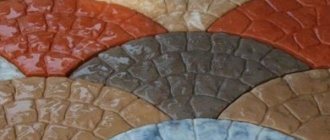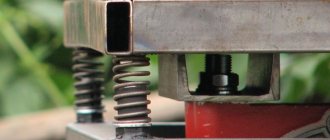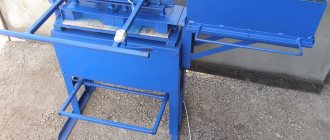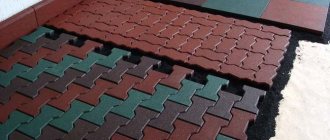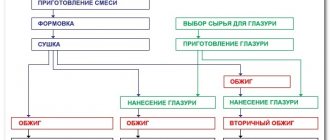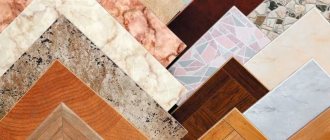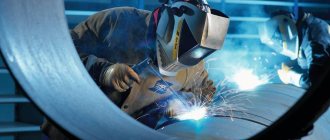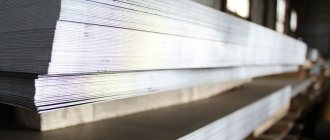Raw material base and production technology
igorkznFORUMHOUSE Member
And between cast and vibro-pressed concrete paving stones (45-60 mm thick) – what to choose for the blind area? I understand that vibration-pressed is a little more expensive than casting. Why? Is it stronger than vibration casting?
Elena Maslova Development Director of the Tsemsis plant
First of all, you need to understand the technologies for producing paving slabs. Vibrocasting is an archaic manufacturing technology, is a completely manual method, and is usually carried out in artisanal conditions . The sand-cement mixture (cement+sand+additive) is loaded into reusable plastic molds with a trowel and compacted on a vibrating table. Next, the forms with the products are transferred to racks for storage. The hardened stone is called "paving slabs".
– The process of producing paving stones using the vibration pressing method is fully automated.
At the first stage, the concrete mixture (cement, sand, crushed stone, additive) is loaded into a special matrix - a mold, and the mixture is compacted under the influence of pressure and vibration. The duration of vibration is controlled using special sensors and occurs until the maximum compaction of the concrete mixture and the required height of the products on the entire technological pallet. Next, the products are immediately stripped and the pallets with the products are automatically transferred to special heat-humidity treatment chambers with the required humidity and temperature parameters to achieve the required concrete strength.
With the automatic production method using the vibrocompression method, in contrast to the vibratory casting method, the concrete composition is designed for various areas of operation in accordance with GOST 17608-2017 “Concrete paving slabs”.
The manufacturer simply cannot use any sand, crushed stone and cement to produce tiles. According to GOST, the quality indicators of inert materials and binders at the incoming inspection, and the physical and mechanical characteristics of the quality of concrete of the finished product at the acceptance inspection are strictly regulated:
- compressive strength;
- bending strength;
- water absorption;
- abrasion;
- frost resistance.
Of course, tiles made by vibration pressing will be “stronger,” more durable and denser than tiles made by vibration casting.
As for the blind area, its main purpose is to protect the basement part of the building from possible waterlogging, ensure reliable drainage of precipitation into the storm drainage system and reduce heat loss associated with sudden temperature changes. A high operational load on the blind area is not expected, cars will not drive in, so paving with paving slabs 40 mm thick will be sufficient.
Compositions of concrete for the production of blocks using semi-dry vibrocompression:
Heavy concrete:
Lightweight concrete:
In the production of wall blocks, three main components are used: binder, aggregate and water. Cement and slow-hardening gypsum can be used as a binder, and sand, crushed stone screenings, expanded clay, slag, ash, sawdust, or any similar local materials capable of creating a durable composition after mixing with the binder and setting it, can be used as a filler. For the manufacture of construction products, all types of cements with a strength grade from 200 to 600 kg/cm can be used.
When using a cement-based mixture, the finished products are aged from one (at a temperature of +15. +45 degrees C) to two (at a temperature of +5. +10 degrees C) days, after which they acquire strength sufficient for storage and transportation. 100% of the strength of the product is acquired after 28 days at a aging temperature of 20 degrees C. If the consumer has a steaming chamber, the products can be subjected to heat treatment for 6.8 hours at a temperature of at least + 50.75 degrees C. In this case, after cooling and drying they acquire 60.80% brand strength.
The selection of the compositions given below was carried out using Portland cement grade 400 (PTs M400). Data for 1 cubic meter of mixture. When using grade 300 cement, cement consumption should be increased by 15%. If it is necessary to increase the strength of products by 10 kg/cm (for example, from grade 30 to grade 40), the consumption of cement in concrete should be increased by 10..15%.
Consumer properties of vibro-cast and vibro-pressed tiles
CrossVikForumHouse Member
Tell me, how do vibro-pressed and vibro-cast paving slabs differ in their consumer properties?
Elena Maslova
Vibration-pressed stone is produced in strict compliance with the requirements for the water-cement ratio. Careful selection of the recipe with the obligatory use of coarse and fine aggregates (crushed stone and sand of various fractions) in strictly defined proportions ensures dense packing of aggregates during layer-by-layer compaction of the concrete mixture. Such tiles have high compressive strength, frost resistance (at least 200 cycles in saline solution) and low water absorption (less than 6%) - the main criteria for quality and durability. In addition, the front layer of vibropressed tiles, due to the technological features of production, has a rough surface, which in turn provides an anti-slip effect during winter operation.
Vibro-cast paving slabs
Vibro-cast paving slabs
Vibropressed paving slabs “Sandstone”
Vibration-pressed paving slabs with a textured surface StoneMix
Vibropressed paving slabs ClorMix “Clinker”
– Vibro-cast paving slabs, due to the high water content in the concrete mixture, have high porosity and, therefore, low density and durability. During the winter period of operation, due to frequent temperature changes, which is especially important for the climatic conditions of the North-Western region, water enters the existing pores and capillaries and, through its wedging effect, destroys the structure of the concrete. The surface of vibro-cast tiles is smooth and glossy, which has a negative impact on off-season use - the formation of ice on the surface; in winter, the surface of the tiles can resemble a skating rink.
The table below shows the comparative characteristics of concrete products made using various technologies.
| Name of physical and mechanical properties | The importance of physical and mechanical properties | |
| Pressing | Vibrocasting | |
| Concrete class by compressive strength | B30 | B22.5 |
| Water absorption | Less than 6 % | More than 7% |
| Abrasion | No more than 0.5 g/cm2 | 0.8 g/cm2 |
| Frost resistance | F200 | F100 maximum |
*Note. The frost resistance grade of concrete is taken to be no lower than F200, while the frost resistance of concrete is determined by saturating concrete slab samples before testing with a 5% aqueous solution of sodium chloride, in accordance with GOST 10060.0.
Preparation of building materials: selection and calculation
In order for the path covering to serve for a long time, you need to determine the appropriate formulation of the finished solution. To make it, the classic concrete recipe is suitable:
- cement – 1 part;
- sand – 2 parts;
- crushed stone - 3 parts.
Composition of mortar for paving slabs
Water is taken in an amount sufficient to obtain a moderately thick mass: not liquid, but not too dense. In order not to prepare the cement mortar with a reserve, you can determine the dimensions of the tile (and therefore the shape) and its volume. This will allow you to find out the amount of concrete. Often paving stones are made 30x30 cm, and a thickness of 4 cm is sufficient. Then the volume will be equal to: 4x30x30 = 3600 cm3 or 0.0036 m3.
At the next stage, the number of such products is calculated, for example, 100 pieces. The total volume of all paving stones will be 0.36 m3. To prepare the solution you will need 6 parts of building materials (the list is given above). Respectively:
0.36/6 = 0.06 m3.
One part is cement. To determine the amount of sand, you need to multiply the value of 1 fraction by 2 (0.12 m3). Accordingly, take 3 parts of crushed stone or 0.18 m3. To understand how much you need to take (in the equivalent of buckets), you need to know the volume of the container - 0.01 m3. But you should not prepare a limited amount of materials. An additional volume of sand, water, crushed stone, etc. may be required. For this reason, a little more materials are prepared - the volume obtained in the calculations is multiplied by 10%.
Wire is used as reinforcement, but in this case you will have to create the frame yourself. You can do it simpler - prepare a chain-link mesh. A suitable option is a cell size of 5x5 cm. An alternative option is a reinforcing mesh for plaster. You can determine the area of the metal layer by knowing the dimensions of the tile:
30x30 = 900 cm2 or 0.09 m2.
In order for the mesh to retain its properties longer and not rust, it must be galvanized. At the next stage, the forms are prepared. You will have to do them yourself. Determine dimensions and configuration. It is easiest to make square or rectangular tiles at home.
Advantages of vibropressed tiles
MadbotFORUMHOUSE Member
I want to put paving stones under the parking lot. I read a bunch of sites and topics. I still don’t understand for myself:
- Is vibrocast still less durable than vibropressed?
- Does vibratory casting have any operational advantages? Or just brighter colors?
- Builders say that with a vibrocast it is easier to wash off dirt with the same Karcher, plus, they say, they have had one for many years and nothing. But I see that in the city it is often split (although vibropressed too). In principle, I wouldn’t say that I definitely want a “glossy” surface, so maybe I’ll stick with a vibropressed one and not worry about it? But for myself, I want to figure it out, maybe vibratory casting has some advantages (besides the appearance, which someone likes).
Elena Maslova
1) Vibro-cast tiles are less durable and dense than vibro-pressed tiles because:
- A) it does not contain crushed stone (the main component responsible for the strength and durability of the concrete product).
- B) its production requires a high content of water, which, when the concrete mixture hardens, evaporates and leaves behind large pores and connecting capillaries. During winter operation, they are saturated with precipitation water and salt reagents; when freezing, the water expands in volume and the concrete is destroyed. In the case of vibration compaction, the pores formed in the concrete are scattered and closed; water cannot penetrate into them from the outside.
- C) with vibratory casting technology, the concrete of a product is compacted under the influence of vibration; with vibrocompression technology, compaction occurs simultaneously under the influence of both vibration and punch pressure, the density of the concrete of a freshly molded product is significantly higher.
– 2) Only bright colors. In general, it is believed that vibro-cast paving slabs are more attractive to the buyer due to the variety of shapes and colors in full color. With the maximum permissible dosage of dye, colored vibrocast tiles turn out duller due to the high water-cement ratio during production. Therefore, manufacturers add more pigment to achieve brighter and richer shades.
However, few people know that high dosages of coloring pigment negatively affect the strength of the finished product.
In addition, vibropressing technology began to use high-quality granular pigment, which has high light resistance, does not fade at all, can be used in low dosages, and produces a bright, beautiful product.
– 3) Of course, dirt is washed off much better from a smooth surface, but with a Karcher you can perfectly wash off dirt from the surface of vibropressed tiles. You can actually find cracked vibropressed tiles in urban public spaces. This is due to the fact that there are two methods for producing vibration-pressed tiles - single-layer pressing and two-layer pressing. With a single-layer method, the main components of the concrete mixture are cement and sand, with a two-layer method, the main layer is cement, sand and crushed stone, the front layer is cement and sand. The main layer of concrete is responsible for the strength and durability of the entire structure, and the front layer is responsible for the aesthetic appearance and wear resistance. These are two different structures, which only in a single integrity provide all the requirements for concrete.
Two-layer tiles are denser, more durable and frost-resistant than single-layer tiles, and even more so than vibro-cast ones. Typically, a single-layer tile can crumble if the production technology is not followed, however, there are also cases that the front layer of a two-layer vibro-pressed tile can fly off during operation. The reason is a violation of the manufacturing technology: incorrectly selected moisture content of the front and main layers of concrete. But this is rare; as a rule, the technology of two-layer vibrocompression provides for complete automation of the process and the influence of the human factor in this case is minimized.
Mixture recipes for vibrocompression
Euro-made products - only the best home-made products of the RuNet! How to make it yourself, master classes, photos, drawings, instructions, books, videos.
Compositions for the manufacture of products by vibration pressing
Options for preparing a solution for pressing per 1 m3 of mixture:
— In the “Number of components” column, the volume of filler in m3 is indicated before the brackets, and its weight in kg is indicated in brackets. Depending on specific local conditions (field, production method, etc.), the density of aggregates may differ from the average densities used in the compositions. In this case, the composition must be adjusted experimentally.
— In the column “Density of concrete” its density is indicated in kg/cubic meter. m. The column “Grade of concrete and solid products” indicates the brand (strength) of concrete or the brand of any solid products made from this concrete (brick stones, plinths, curbs, etc.) in kg/cm 2 .
— In the column “Brand of hollow stone” the brand in kg/cm2 of hollow wall stones measuring 390x190x188 mm and hollow partition stones is indicated. The strength of these products is lower than the strength of concrete due to the presence of voids.
— In sawdust concrete compositions it is allowed to use any sawdust untouched by rot, however, softwood sawdust is preferable to hardwood sawdust because swell less. To improve the preservation of sawdust in concrete, it is advisable to introduce the Proston D-18 accelerator into the compositions in an amount of up to 2% by weight of cement.
— Of the indicated compositions, concrete with a minimum density has the best thermal insulation properties: the “warmest” is concrete with a density of 880 kg/cu. m, the “coldest” - with a density of 2300 kg / cubic meter. m.
Cement-based compositions:
HEAVY CONCRETE
Concrete density kg/m3
Grade of concrete and solid block kg/cm2
Brand of hollow block kg/cm2
Concrete on sand and crushed stone.
Cement, kg Sand quartz m3 (kg) Water, l.
240 1,15 (1950) 90…130
Cement, kg Sand quartz. M3 (kg) Dolomite or limestone crushed stone, m3 (kg) Water, l
200 0,54 (920) 0,65 (980)
Cement, kg Dolomite or limestone screenings, m3 (kg) Dolomite or limestone crushed stone, m3 (kg) Water, l
200 0,3 (450) 0,8 (1200) 90…130
Cement, kg Dolomite or limestone screenings, m3 (kg) Water, l
Cement, kg Quartz sand, m3 (kg) Granite crushed stone, m3 (kg) Water, l
200 0,54 (920) 0,65 (1100) 90…130
Concrete on brick waste
Cement, kg Clay waste. Or silica. Brick fraction. 2…15 mm, m3 (kg) Quartz sand, m (kg) Water, l
230 0,9 (990) 0,32 (540) 90…130
LIGHTWEIGHT CONCRETE
Expanded clay concrete
Cement, kg Expanded clay, m3 (kg) Water, l
250 1,2 (720) 100. 150
Cement, kg Expanded clay fraction. 0.5 mm, m3 (kg) Expanded clay fraction. 5. 15 mm, m3 (kg) Water, l
220 0,65 (390) 0,6 (330) 90. 130
Ash concrete
Cement, kg Coal ash. or slate, m3 (kg) Water, l
200 1,2 (960) 90. 130
Cement, kg Coal ash or oil shale. m3 (kg) Quartz sand, m3 (kg) Water, l
220 0,9 (720) 0,32 (540) 90. 130
Cement, kg Crushed dolomite or limestone, m3 (kg) Coal ash. or slate, m3 (kg) Water, l ¦ 9O. 13O
200 0,5 (750) 0,53 (420) 90. 130
Expanded clay concrete
Cement, kg Expanded clay fraction. O. 5 mm, m3 (kg) Expanded clay fraction. 5. 15 mm, m3 (kg) Coal ash. or slate. m3 (kg) Water, l
200 0,65 (390) 0,55 (300) 0,44 (350) 90. 130
Cinder concrete
Cement, kg Granulated slag, m3 (kg) Water, l
200 1,3 (720) 90. 130
Cement, kg Granulated slag, m3 (kg) Quartz sand, m3 (kg) Water, l
200 0,9 (500) 0,32 (540) 90. 130
Cement, kg Boiler slag, m3 (kg) Water, l
200 1,2 (1080) 90. 130
Cinder concrete
Cement, kg Boiler slag, m3 (kg) Quartz sand, m3 (kg) Water, l
200 0,8 (720) 0,32 (540) 90. 130
Ash and slag concrete
Cement, kg Boiler slag, m3 (kg) Coal ash. or shale, m3 (kg) Water, l
200 0,8 (720) 0,4 (720) 90. 130
Sawdust concrete
Cement, kg Sawdust, m3 (kg) Quartz sand, m3 (kg) Water, l
260 0,6 (150) 0,65 (1100) 100. 150
Cement, kg Sawdust, m3 (kg) Quartz sand, m3 (kg) Water, l
280 0,4 (100) 0,8 (1350) 100. 150
Cement, kg Sawdust, m3 (kg) Quartz sand, m3 (kg) Lime paste, m3 (kg) Water, l
230 0,9 (220) 0,3 (500) 0,04 (50) 100. 150
Expanded clay sawdust concrete
Cement, kg Cramsite, m3 (kg) Sawdust, m3 (kg) Water, l
280 0,7 (420) 0,6 (150) 100. 150
How does the water-cement ratio affect the characteristics of tiles, visual control method
SerdocForumHouse Member
There are many nuances regarding vibro-compressed tiles, as well as vibro-cast tiles: if the volume of water is exceeded during the production of vibro-cast tiles, the tile will collapse if all other standards are observed. But the production of vibration-pressed mixtures requires a rigid cement-bonded mixture, and excess water leads to sticking in the press, and a drier mixture leads to destruction. Tiles made from a dry mixture absorb water very strongly and take a long time to dry, and with the maximum possible amount of water, on the verge of sticking, they absorb little and dry quickly like natural stone. These two factors are very important and also affect service life and appearance, which is well known to manufacturers.
Elena Maslova
This is true. It is necessary to correctly select the water-cement ratio for any method of producing paving slabs. However, in the case of vibration pressing, this nuance is limited, the production process is automated, any mixer is equipped with humidity sensors, and the dosage of water flow is regulated by a hygrometer. In the case of vibration compaction, it is necessary to obtain the maximum possible moisture content of the concrete mixture, which is assessed visually according to the criterion of the formation of “scores” and “broaches” along the side surfaces of the product.
In the photo on the left - tiles with optimal humidity, on the right - from a dry mixture
Self-production
The production of sidewalk elements with your own hands must begin with preparing a place for molding and storing products. Even with high mobility of the resulting mixture, after filling the molds, they must be compacted. Submersible or homemade vibrators are suitable.
Compaction should be carried out for no more than 5–10 s, otherwise the mixture will stratify and the appearance of the pavement elements will deteriorate.
Standard recipe
When producing a composite with strength class B25, you can use the following composition per 1 m3:
- cement = 390 – 420 kg;
- sand = 700 – 750 kg;
- crushed stone = 1000 – 1050 kg;
- water = 155 – 165 kg;
- plasticizer + pigment (if desired, color the products).
Mixing technology
When mixing the components, sand is first loaded, then water with additives and cement, and lastly crushed stone. Mixing is carried out for at least 2 - 3 minutes until a homogeneous material is obtained.
Paving slabs made of concrete of this composition will have intense hardening kinetics, so it is very important to prevent moisture loss from its surface.
Conclusion
Vibropressed paving slabs are a universal, extremely strong and durable material. And if at the beginning of the development of technology the choice of shapes and colors was limited, today a brick making press is in no way inferior to casting in terms of decorativeness. Naturally, if we talk about high-quality factory products. Coupled with compliance with paving technology, tied to the type of soil and groundwater level, the finishing layer of vibropressed tiles is “set and forget” until you get tired of it.
You can read more about paving technology for different conditions in one of the previous materials. For those who have an acute issue of frost heaving - about budget and reliable paths for clay soils and high groundwater level. The video shows the rules for laying paving slabs from a specialist.
Subscribe to our Telegram channel Exclusive posts every week
About the process
To make tiles at home that would be impossible to distinguish from factory ones, you only need one expensive device - a concrete mixer. It is quite possible to purchase the remaining tools, as well as raw materials, at affordable prices.
What equipment you need:
- vibration table (you can make it yourself);
- molds for paving slabs;
- metal bucket;
- shovel;
- level;
- gloves;
- hammer with rubber tip.
What raw materials are needed:
- high-quality cement (grades above A 400);
- dyes for cement (you can do without them, but gray tiles are boring);
- plasticizer;
- granotsev;
- mold lubricant.
